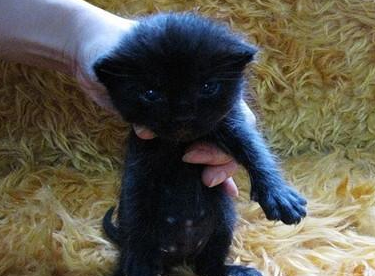Many cat owners like to feed their cats with homemade food, not knowing that too much fat in homemade fish can easily cause fat inflammation and pain in cats, while too much vitamin A in homemade chicken liver can easily cause arthritis in cats. Therefore, in order to make cats grow healthier, it is very important to guide cats to change to professional cat food.

I. Care of Bombay cats
Trimming cat claws
The claws of the Bombay cat are the cat’s tools for trapping mice, climbing and self-defense. If the owner keeps the cat for catching mice, of course the claws should not be trimmed. If the owner keeps the cat as a companion animal, the cat’s claws should be trimmed frequently to avoid scratching people, clothes, furniture, floors, etc. Claw trimming should start from a young age, once a month or so. The specific method is as follows.
Hold the Bombay cat in your arms, grasp 1 foot of the cat with your left hand, and slightly squeeze it with your thumb, index finger and middle finger to make the claw extend. Then use the nail clipper in the right hand to carefully cut the transparent part of the front of the claw, and then use the small file on the nail clipper to polish the claw. When trimming, do not cut too much to avoid hurting the feet of the Bombay cat. Then cut and polish the other claws in turn.
Grooming the coat
The Bombay cat has a rough tongue with special barbed tongue papillae, which resembles a comb. The Bombay cat often uses tongue licking to groom the coat. The parts that cannot be licked, such as the head, shoulders, back and neck, are groomed with the claws. Even so, it is best to groom the cat once a day. Because cats shed all year round, especially in the spring and autumn hair changing seasons, cats grooming themselves will swallow the hair into the stomach, over time in the stomach to form a hair ball, such as can not be vomited out through the vomit, and can not be discharged in time through the intestines, stagnant in the stomach, will form a hair ball blockage, affecting appetite, and even life-threatening.
When grooming, comb not only with the coat, but also against the coat. When grooming, the Bombay cat can be wetted with water and then rubbed to make the coat tree up and easy to comb. For long-haired cats, if the coat is tangled or stuck together, use the fingertips to open it, or use a thin-toothed comb and comb slowly and carefully. If the felt has been rolled out, use scissors to cut the felt into thin strips in the direction of hair growth, and then use a comb to comb it out. If the felt rolling is serious, the hair can be cut off to make it grow again.
Second, the Bombay cats can not eat food
The following foods are prohibited or cautioned for Mumbai cats.
1. stimulating foods, such as pepper, mustard, spicy oils.
2. over-fattening food.
3. Too cold and too hot food, the tongue of the Bombay cat is afraid of heat and the body will reject food that is too cold and too hot.
4. offal, which contains vitamin A, but too much is damaging to the bones of the cat.
5, onions, will destroy red blood cells and cause anemia, which can lead to serious death.
6, aquatic products, such as octopus, squid – cause indigestion, vomiting, and can cause death.
7, cookies, sweets are prone to tooth decay.
8, chicken bones, fish bones, not easy to digest, and even stabbing gastrointestinal.
Bombay cats are carnivores and meat and fish are high in phosphorus and rich in animal protein, but eating these foods alone can cause a lack of calcium. In addition, to prevent constipation in Bombay cats, you can give him some vegetables and fruits, such as spinach.
The ideal cat food should contain vitamins, phosphorus, potassium, calcium, amino acids and protein, and should be cooked lightly. The diet of cats is different from that of humans, and we should not make our own preferences as the food of Mumbai cats.
III. Training of Bombay cats
Training Bombay cats not to jump on the bed by
The breeder should first train the Mumbai cat to develop the habit of sleeping in its own special litter, and should prepare a particularly comfortable litter for the cat before training, and put a warm water bag in the litter in winter. If the cat is still unwilling to sleep in the litter after these measures, a cover can be placed on top of the litter so that it cannot run outside. After several training sessions, the cat will not run outside and certainly will not sleep in the nest.
There are also the following more direct methods.
Direct punishment method: When the cat gets into bed or into the owner’s phi nest, immediately slap the cat’s buttocks with your hand, or slap the cat with a newspaper roll or book, and loudly reprimand the cat to drive it out of bed. At this time, the owner’s attitude must be stern and show a vicious and angry look. As the cat is very sensitive to the owner’s emotions, as long as the owner expresses exasperation, it will not dare to go to bed to get under the covers again.

